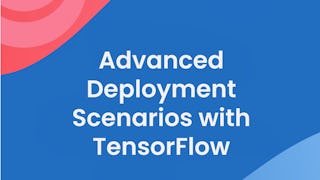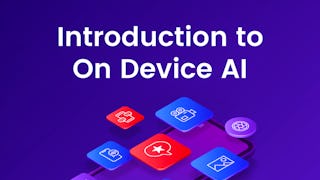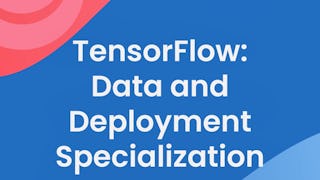Bringing a machine learning model into the real world involves a lot more than just modeling. This Specialization will teach you how to navigate various deployment scenarios and use data more effectively to train your model.
Unlock access to 10,000+ courses with Coursera Plus. Start 7-Day free trial.

Device-based Models with TensorFlow Lite
This course is part of TensorFlow: Data and Deployment Specialization

Instructor: Laurence Moroney
32,480 already enrolled
(653 reviews)
Recommended experience
What you'll learn
Prepare models for battery-operated devices
Execute models on Android and iOS platforms
Deploy models on embedded systems like Raspberry Pi and microcontrollers
Skills you'll gain
Details to know

Add to your LinkedIn profile
4 assignments
See how employees at top companies are mastering in-demand skills

Build your subject-matter expertise
- Learn new concepts from industry experts
- Gain a foundational understanding of a subject or tool
- Develop job-relevant skills with hands-on projects
- Earn a shareable career certificate

There are 4 modules in this course
Welcome to this course on TensorFlow Lite, an exciting technology that allows you to put your models directly and literally into people's hands. You'll start with a deep dive into the technology, and how it works, learning about how you can optimize your models for mobile use -- where battery power and processing power become an important factor. You'll then look at building applications on Android and iOS that use models, and you'll see how to use the TensorFlow Lite Interpreter in these environments. You'll wrap up the course with a look at embedded systems and microcontrollers, running your models on Raspberry Pi and SparkFun Edge boards. Don't worry if you don't have access to the hardware -- for the most part you'll be able to do everything in emulated environments. So, let's get started by looking at what TensorFlow is and how it works!
What's included
14 videos8 readings1 assignment1 programming assignment1 ungraded lab
Last week you learned about TensorFlow Lite and you saw how to convert your models from TensorFlow to TensorFlow Lite format. You also learned about the standalone TensorFlow Lite Interpreter which could be used to test these models. You wrapped with an exercise that converted a Fashion MNIST based model to TensorFlow Lite and then tested it with the interpreter. This week you'll look at the first of the deployment types for this course: Android. Android is a versatile operating system that is used in a number of different device type, but most commonly phones, tablets and TV systems. Using TensorFlow Lite you can run your models on Android, so you can bring ML to any of these device types. While it helps to understand some Android programming concepts, we hope that you'll be able to follow along even if you don't, and at the very least try out the full sample apps that we'll explore for Image Classification, Object Detection and more!
What's included
15 videos4 readings1 assignment
The other popular mobile operating system is, of course, iOS. So this week you'll do very similar tasks to last week -- learning how to take models and run them on iOS. You'll need some programming background with Swift for iOS to fully understand everything we go through, but even if you don't have this expertise, I think this weeks content is something you'll find fun to explore -- and you'll learn how to build a variety of ML applications that run on this important operating system!
What's included
22 videos9 readings1 assignment
Now that you've looked at TensorFlow Lite and explored building apps on Android and iOS that use it, the next and final step is to explore embedded systems like Raspberry Pi, and learn how to get your models running on that. The nice thing is that the Pi is a full Linux system, so it can run Python, allowing you to either use the full TensorFlow for Training and Inference, or just the Interpreter for Inference. I'd recommend the latter, as training on a Pi can be slow!
What's included
13 videos9 readings1 assignment
Earn a career certificate
Add this credential to your LinkedIn profile, resume, or CV. Share it on social media and in your performance review.
Instructor

Offered by
Explore more from Software Development
 Status: Free Trial
Status: Free TrialDeepLearning.AI
 Status: Free
Status: FreeDeepLearning.AI
 Status: Free Trial
Status: Free TrialDeepLearning.AI
 Status: Free Trial
Status: Free TrialDeepLearning.AI
Why people choose Coursera for their career




Learner reviews
653 reviews
- 5 stars
78.01%
- 4 stars
16.18%
- 3 stars
4.27%
- 2 stars
0.76%
- 1 star
0.76%
Showing 3 of 653
Reviewed on Apr 10, 2020
The course was a good one from the instructor. Could have made it more interesting. But anyways a good starter course for anyone.
Reviewed on Oct 12, 2020
Really informative course on tf lite for beginners like me, it has given serious thoughts about the EDGEML field and opportunities , thanks coursera and deeplearning.ai for this kind of courses.
Reviewed on Jul 15, 2020
Laurence is a good teacher. His explanations are clear and to the point. This is a one of the best sources to learn how to deploy ML models on devices

Open new doors with Coursera Plus
Unlimited access to 10,000+ world-class courses, hands-on projects, and job-ready certificate programs - all included in your subscription
Advance your career with an online degree
Earn a degree from world-class universities - 100% online
Join over 3,400 global companies that choose Coursera for Business
Upskill your employees to excel in the digital economy
Frequently asked questions
To access the course materials, assignments and to earn a Certificate, you will need to purchase the Certificate experience when you enroll in a course. You can try a Free Trial instead, or apply for Financial Aid. The course may offer 'Full Course, No Certificate' instead. This option lets you see all course materials, submit required assessments, and get a final grade. This also means that you will not be able to purchase a Certificate experience.
When you enroll in the course, you get access to all of the courses in the Specialization, and you earn a certificate when you complete the work. Your electronic Certificate will be added to your Accomplishments page - from there, you can print your Certificate or add it to your LinkedIn profile.
Yes. In select learning programs, you can apply for financial aid or a scholarship if you can’t afford the enrollment fee. If fin aid or scholarship is available for your learning program selection, you’ll find a link to apply on the description page.
More questions
Financial aid available,